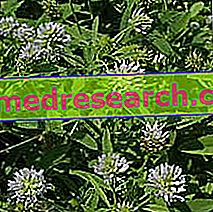
Scientific name
Trigonella foenum-graecum
Family
Leguminosae
Origin
Asia
Used Parts
The seeds are used in the plant
Chemical constituents
- Mucilage (25-45%);
- Proteins (25-30%);
- Steroidic saponins (diosgenin);
- Alkaloids, among which we find the trigonellina;
- Flavonoids;
- sterols;
- fibers;
- Vitamins;
- Mineral salts;
- Polysaccharides;
- Essential oil (0.01%).
Fenugreek in Herbalism: Properties of Fenugreek
Fenugreek was used in folk medicine to combat intestinal parasites or as a hepatoprotector and galactogogue (favoring lactation). Fenugreek has always been known and appreciated as a "tonic", anti-anemic, anabolic and anti-ulcer, lipid-lowering and hypoglycemic.
The hypoglycemic action of fenugreek is modest, and in any case not only due to the fibers. The tonic-stimulating activity is instead exploited in the prevention and treatment of the leanness of adults and children.
Fenugreek flour, in poultices, is used by folk tradition against pimples, leg ulcers and oily and impure skin. In modern phyto-cosmetics, fenugreek finds its place in firming, emollient, anti-stretch mark and anti-wrinkle products.
Biological activity
The use of fenugreek has been officially approved to counteract the loss of appetite (internal use) and for the treatment of skin inflammation (external use).
These activities seem to be exercised above all by the mucilages contained in large quantities inside the seeds of the plant. In fact, taken internally, the mucilages have proved useful in combating inappetence; while if used externally, in the form of cataplasm, they exert a local emollient action that can be very useful in the case of phlogistic states.
However, these are not the only properties ascribed to fenugreek. In fact, hypoglycemic and hypolipidemizing activities are also attributed to the plant.
The hypoglycemic activity has been confirmed by several studies, even if the exact mechanism by which it is still explained has not been accurately identified. However, from some studies carried out, it seems that the plant exerts its action favoring the secretion of insulin by the β-cells of the pancreas and, at the same time, inhibits the activity of enzymes involved in the metabolism of carbohydrates, such as saccharase and alpha-amylase.
Also the lipid-lowering properties have been confirmed by several studies. More specifically, it has been shown that saponins contained in fenugreek seeds are able to lower both triglyceride levels, LDL levels and total cholesterol levels.
However, the aforementioned therapeutic applications of fenugreek have not yet been officially approved, although this plant is readily available in dietary supplements whose purpose is to control cholesterol levels and assist metabolism and metabolism. carbohydrates.
Fenugreek against inappetence
As mentioned, thanks to the action carried out by the mucilages contained in the seeds of fenugreek, this plant has proved to be an effective remedy to counteract the loss of appetite.
Generally, to promote appetite, it is recommended to take two grams of drug three times a day, just before the main meals.
For more information about the dosage of fenugreek to be used to promote appetite, we recommend reading the article dedicated "Taking care of fenugreek".
Fenugreek against skin inflammation
The mucilages contained in the seeds of the fenugreek, when used externally, exert an emollient type activity and for this reason they are successfully used in the treatment of skin inflammations.
In this case, fenugreek can be used as a poultice to be applied to the affected area. For the preparation of the product, it is generally advisable to add 50 grams of powdered seeds to 250 ml of boiling water and to leave it in immersion for at least five minutes.
Also in this case, for further information, please refer to the dedicated article "Taking care of fenugreek".
Fenugreek in folk medicine and in homeopathy
In folk medicine, fenugreek is used internally to treat diabetes and catarrh of the upper respiratory tract; moreover, it is used as a galactogogue remedy.
Externally, however, fenugreek is used in traditional medicine to counteract inflammation, skin ulcers and eczema.
In Chinese medicine, fenugreek is used as a remedy to combat hernia and impotence. While in Indian medicine the plant is used for the treatment of vomiting, anorexia, colitis, fever, cough and bronchitis.
Fenugreek is also used in homeopathic medicine as a hypoglycemic, cholesterol-lowering remedy and to prevent cardiovascular diseases; besides being used in the treatment of anorexia.
The amount of remedy to be taken can vary from one individual to another, also depending on the homeopathic dilution that is intended to be used.
Contraindications
Avoid use in case of hypersensitivity to one or more components. Fenugreek preparations should not be used during pregnancy as they increase uterine contractility.
Pharmacological Interactions
- possible addition of effects with oral hypoglycemic agents;
- potential interactions with hormonal and anticoagulant therapies;
- felibutazone and reserpine: fenugreek prevents ulcerative lesions from drugs;
- Fenugreek fibers can reduce the absorption of orally administered drugs.



